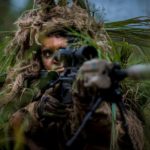New Ghillie Suit for Army Snipers put to the Test
By Debbie Gregory.
A new, lightweight ghillie suit for snipers is being tested to replace the current Flame Resistant Ghillie System, or FRGS, that will be more functional for troops in hot environments.
The proposed Improved Ghillie System (IGS) a modular system that would be worn over the field uniform.
During the three day testing at Eglin Air Force Base, Florida, snipers concealed themselves in a forest setting while other snipers tried to spot them from distances from 33 to 655 feet.
A ghillie suit is a type of camouflage clothing designed to resemble the background environment such as foliage, snow or sand. Typically, it is a net or cloth garment covered in loose strips of burlap, cloth or twine, sometimes made to look like leaves and twigs, and optionally augmented with scraps of foliage from the area.
Program Executive Office Soldier developed the IGS. Components include sleeves, leggings, veil and cape that can be added or taken off as needed.
The Army plans to buy about 3,500 IGSs to outfit the approximately 3,300 snipers in the service, as well as Army snipers in U.S. Special Operations Command.
The ghillie suit was developed by Scottish gamekeepers as a portable hunting blind. Lovat Scouts, a Scottish Highland regiment formed by the British Army during the Second Boer War, is the first known military unit to use ghillie suits.
The IGS features a lighter, more breathable fabric than the material used in the FRGS, and offers some flame-resistance, but soldiers will receive most of their protection from their Flame Resistant Combat Uniform, worn underneath the IGS, Army officials said.
Snipers, except for those fighting in urban terrain, traditionally spend much of their shooting time in a “creep,” pursuing a target in the prone position. A soldier’s creation of his first ghillie suit is seen as a rite of passage into the sniper community.








